This emphasis is released towards the outside halfway up the right loop. With warm skin contact, the heel of the hand now glides over the top inwards in the direction of the spine.
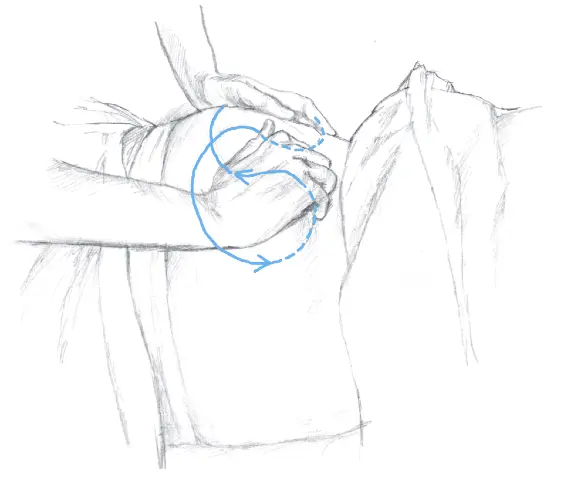
Ill. 12
On the arc downwards – away from the spine – I engage again and then slide theheel of my hand softly over the sacrum.
This engagement continues up half the height of the second loop. At the outer arc, I release it again until the left loop descends inwards towards the spine.

Ill. 13
There is renewed engagement on the inner arc before the ‘harmonious eight’ is finally completed at the point of intersection, and the patient becomes aware of the latter through an intense build-up of warmth (‘small fire’). In its dynamics, therefore, the movement breathes between emphasis (below) and release (above).
During emphasis, a warm, soft contact by the heel of the hand increases the intensity of the movement in this area. Having performed this several times, I finish the Einreibung after a right loop with a downstroke in the centre. During this downstroke, too, my fingers point towards the head.
EFFECT
Warming; waking; raising; activating; stimulating initiative.
INDICATIONS
Morning ‘grouchiness’; listlessness; depression; tired legs; sciatica.
NOTE
Use only in the morning! Do not perform energetically!
7. The Good Night lemniscate
Remaining on the patient’s left side, only the lower part of the back and the buttocks are uncovered, approximately to the coccyx.
Throughout the treatment, my left hand rests lightly on the patient’s left waist. Starting below the sacroiliac joint (Articulatio sacroiliaca), I use my right hand to make a small lemniscate that runs transversely to the back.

Ill. 14
My fingers always point to the right side of the patient.
I start at centre of the lemniscate, first following the loop to the right, then to the left. Each loop begins with an emphasis on the lower arc.
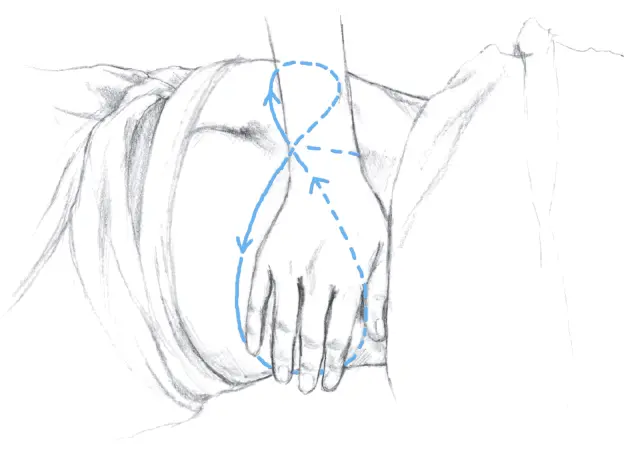
Ill. 15
When dipping into the tissue, my hand – starting with the fingertips through the middle of the hand to the heel of the hand – nestles completely into the shape of the body. On the outside right, my hand releases from its emphasis and glides smoothly in reverse order (heel of the hand – middle of the hand – fingertips) back to the crossing point via the upper arc.
There I dip back into the tissue at the beginning of the left loop.
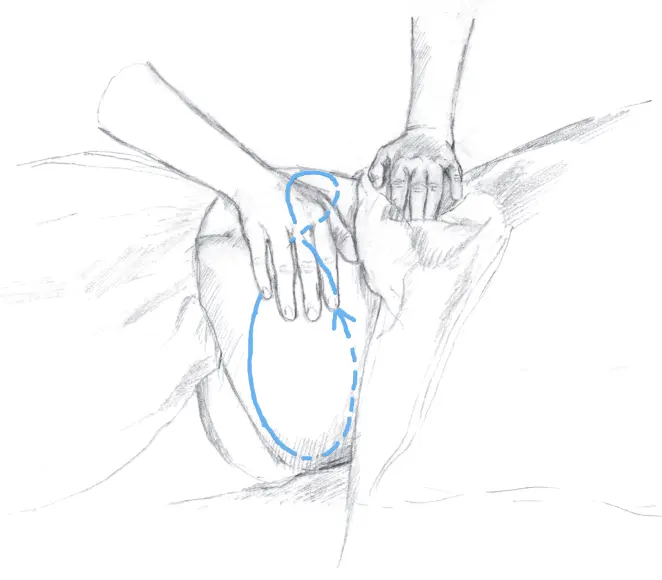
Ill. 16
With emphasis in the lower arc, my hand now glides to the patient’s left side. Led again by the fingertips – as in the beginning – the lemniscate is finally completed with an upper arc.

Ill. 17
My hand always stays in relaxed and warm contact with the skin. In its dynamics, the movement breathes between emphasis (below) and release (above).
Having performed it several times, I finish the Einreibung after a right loop with a downstroke in the centre.
During this downstroke, too, my fingers point to the right side of the patient.
EFFECT
Relaxing; soothing; promoting sleep. The warmth of the gluteal muscles stimulates the flow of warmth to feet.
INDICATIONS
Sleeplessness; mental states of excitement.
NOTE
Wrong emphasis (upwards) would result in overstimulation of kidney activity, i.e. excretion.
Einreibung of the shoulder girdle
8. Neck release (‘Christmas tree’)
The patient sits in an upright and relaxed position on a chair or on a massage table; the patient's feet rest on a firm surface (such as a stool or the floor).
A pillow on the lap allows the forearms to be supported; the neck and upper arms of the patient remain relaxed.
The patient is covered to the neck in a blanket; its upper ends overlap behind the back. When uncovering the back, the two ends are opened rearwards to the right and left, so that they hang down loosely on each side; the shoulder joints remain covered.
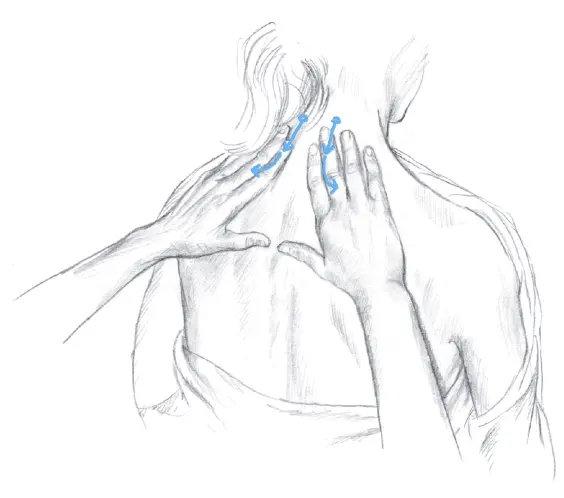
Ill. 18
Standing behind the patient, the fingertips of both my hands dip simultaneously into the tissue of the neck (trapezius muscle) to the left and right of the seventh cervical vertebra (Vertebra prominens).
My fingertips point diagonally upwards towards the spine, while the thumbs form a horizontal line without touching each other. The shape of a triangle is thus created between my hands.

Ill. 19
Successively from the index finger to the little finger, I begin to engage the tissue until at last all fingers have full skin contact. As a result, the tissue bulges convexly outwards and ‘swells’ slightly.
At that moment my splayed thumbs dip in supportively between the shoulder blades and initially remain in that position. Without moving the wrists, my fingertips – carrying the tissue along – now flow in parallel to the spine towards the thumbs which, through their position, hold back the current coming from above, allowing it to peak through the engagement.
Perceiving this, both thumbs, together with the other fingers, slide in a slight downward arc at first to the inner edge of the shoulder blades.
In doing so, the fingers and thumbs release the emphasis so that the current can pour down from above in a liberating way.
Then my fingers, with light skin contact, glide upwards on the shoulder blades, completing the first circular motion.
The second immersion begins just below the first starting point at the level of the first thoracic vertebra. The third immersion is at the level of the second thoracic vertebra, etc. The last immersion is done such that the thumbs can still touch the bottom edge of the shoulder blades when stroking.
Thus there is a continuous circling process which is first emphasised in the area of the spine and then released again outwards.
In this way the area between the shoulder blades breathes deeply. Repeat the entire Einreibung several times!
EFFECT
Конец ознакомительного фрагмента.
Текст предоставлен ООО «ЛитРес».
Прочитайте эту книгу целиком, купив полную легальную версию на ЛитРес.
Читать дальше
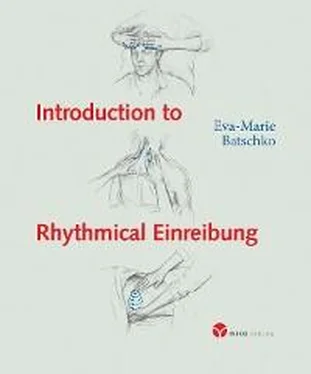










![Andrew Radford - Linguistics An Introduction [Second Edition]](/books/397851/andrew-radford-linguistics-an-introduction-second-thumb.webp)








